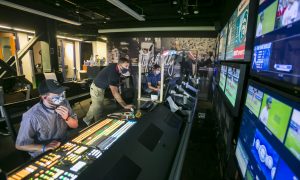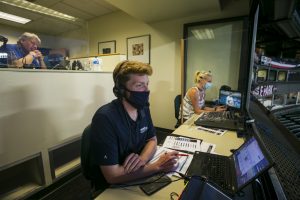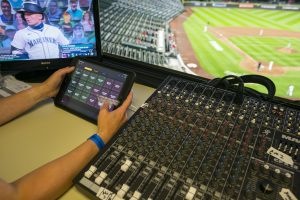At the Ballpark: Mariners Productions Keeps Players, Onsite Staff on Schedule With In-Venue Routine at T-Mobile Park
Traditional videoboard, audio elements help maintain timing and pace
Story Highlights
Although Major League Baseball is continuing with a 60-game regular season, the pulse of what makes professional baseball exciting will remain at home. In the midst of the ongoing COVID-19 pandemic, 30 in-venue departments are forging ahead with operations inside empty stadiums. SVG’s At the Ballpark series will take you behind the control-room door and examine what it’s like to produce a fan-less venue experience in 2020.
“Let me just tell you. After working from home, it’s nice to walk into the ballpark and see the baseball field.”
It’s a lot like your first-ever visit to a professional stadium, and Ben Mertens, senior director, Mariners Productions, echoes a lot of his colleagues in Major League Baseball and their excitement at being back in action. Unfortunately, there’s a catch when it comes to live sports productions in the age of COVID-19.
MORE AT THE BALLPARK INTERVIEWS:
- DodgersVision Leverages New Audio System, Blend of Traditional and Contemporary Content
- DBTV Productions Uses Chase Field as Testing Ground for New In-Venue Approach
- Minnesota Twins Infuse Personal Touches in Player-Centric Videoboard Production
- Tampa Bay Rays Integrate Social-Media Content, Fan Videos on Tropicana Field Videoboards
- Cincinnati Reds Use Unique Season To Learn New HDR Videoboard
- New York Mets’ In-Venue Show Entertains Players On-Field
- Detroit Tigers Focus on Fan Engagement, Rely on Scrimmages for In-Venue Strategy
“It’s a different environment,” he explains. “There are signs and new control-room protocols where we have occupancy rates on how many people can be in the room and where they can sit. You also have to sanitize your hands before you come in, and you have to wear a mask when you’re in the facility unless you’re in an isolated room.”
A Layer of Safety: Stadium Protocols Cover Temperature Checks, Tiering System
Things may look different inside the facility, but the league has made sure to designate tier-specific zones that are accessible only by credentialed individuals. Players, coaches, on-field personnel, and other support staff — trainers, equipment managers — are in Tier 1, the core of this newly developed infrastructure. Tier 2 comprises individuals who come into contact with the aforementioned Tier 1. Mertens and his staff are assigned to Tier 3. In Tier 3, members of the Seattle Mariners’ in-venue team must do additional policing before reaching the control-room door. “Some of us have to take our temperature a couple of times to get two readings, you may have to fill out an application to find out if you have any COVID-19–related symptoms, and, if all that checks out, you’re granted access to come into the ballpark,” he says. “When you pull into the stadium, you almost go through the same process again. Once you get through all of that, you get to walk into the building.”

Mariners Productions’ Ben Mertens (standing) and his colleagues power in-venue elements from the control room in T-Mobile Park.
In addition to a limited number of people in the control room, the space has gained non-technological features to curb the spread of the virus, including plexiglass dividers and the mandatory wearing of masks and other personal protective equipment.
With occupancy capped, the team is moving toward a more spread out approach in which many rooms are shared between departments.
“We’ve had to take positions that were typically in the control room, like our producer and our PA announcer, and move them into another part of the building to maintain social distancing,” Mertens explains. “There are also restrictions on when you can come into the ballpark and how long you can be here, but, once you get into your seat, it’s kind of back to normal procedures to getting ready for game day.”
Creatures of Habit: Videoboard, Audio Elements Maintain Pace of Proceedings
The game of baseball is built on superstitions and is played by individuals who love a daily routine. Without fans in the stands, it could be difficult to keep track of time and understand where a player or staffer is on their respective to-do lists prior to first pitch. Therefore, the in-venue team has assumed the role of unofficial timekeeper and uses regular visual and auditory cues to indicate the specific stages of a pregame.

Employees are sharing rooms in the stadium and practicing mandated safety protocols, including wearing masks and staying behind plexiglass dividers.
“Fans are always the number-one priority during a game at T-Mobile Park,” says Mertens, “but we also have other audiences that consume what we do. We’re using simple things like the national anthem or the starting lineups because they’re consistent in the show. The players use that as cues for themselves to say, ‘Hey, this is where I should be in my game prep.’ We’re providing that consistency that they’re used to.”
It’s not just for the players. This material is not only keeping the broadcast and radio networks in line between innings but also giving additional context for audiences tuning in.
“If we weren’t playing walkup music, claps, or charge, the broadcast itself would sound different,” he notes. “We want to make sure that, even though the fans can’t be here, they’re still consuming what the atmosphere is like at the ballpark through those other mediums of television, radio, or streaming.”
Sound is playing a huge part during this shortened-season, and, on the broadcast end of the spectrum, the in-venue team is responsible for fake crowd noise. To make the audio mix sound as authentic and real as possible, the team at Mariners Productions is even more locked into the action on the field.
“To do it well, ,” says Mertens, “you have to be paying close attention to the game. You can’t be checking your phone or having a conversation with somebody on comms, because you don’t know when something’s going to happen in the game of baseball. Getting the sense and rhythm of a game but also watching previous broadcasts and understanding what it sounds like were key points in the learning process.”
Reporting for Duty: Cardboard ‘Seat Fleet’ Play a Unique Role in Empty Stadium
Without fans in the stands, these gargantuan stadiums feel cavernous and hollow. In lieu of actual human beings, numerous teams around the league have produced cardboard cutouts of their own fans. In Seattle’s case, they’re sticking to their maritime roots with the Seat Fleet. Some may scoff at the idea, but the initiative has supplied an extra wrinkle to the in-venue broadcast.
“They’re playing the role of providing texture,” Mertens notes. “When we go back and look at some highlights and some things that we shot with one of our internal cameras, it looks like there are real people when you focus on the subject matter in the batter’s box.”

Fake crowd noise is generated via an iPad, with sounds captured from the popular MLB The Show videogame.
Despite the silence from these “fans,” the team is leveraging the inanimate objects at the center of some of their entertainment pieces.
“We’re doing some silly things with the 7th-inning stretch, where we’ll go out and shoot the cardboard cutouts and put them up underneath the lyrics,” he says. “There are also some other traditional Mariners game entertainment elements. We have an individual, called The Bad Dancer, who’s a lifelong fan who shows up at the ballpark occasionally in the right-field seats, and, if we ever put a camera on him, he would just dance badly. We made sure that there’s a cardboard cutout of him in our right-field upper-deck seats.”
Curtain Call: The Notable Names of Mariners Productions
The control room layout is not a traditional one, but it’ll suffice if it means a return to baseball. All staffers under the umbrella of Mariners Productions may not work in one room during a game, but the tireless work of everyone involved boosts the energy of the Pacific Northwest faithful in the confines of T-Mobile Park.
“The team has absolutely crushed it so far, and, without them, we couldn’t be doing what we’re doing,” says Mertens. “[Director, Marketing] Mandy Lincoln, [Manager, Marketing] Tyler Thompson, [VP, Marketing] Gregg Greene, [Manager, Video Operations] Eric Vaughn, [Motion Graphics Designer] Sam Findlay, [Video Editor] Dan Oleskowicz, and so many others within the Marketing & Communication team, have made this challenging and unique season a successful one so far. Now that we’re getting more comfortable with the new situation, I can’t imagine what we’re going to continue to come up with and how creative we’re going to be during the remaining part of the season.”
Mariners Productions will return to the control room next week for the start of a five-game homestand featuring the Los Angeles Dodgers (Aug. 19-20) and Texas Rangers (Aug. 21-23).
